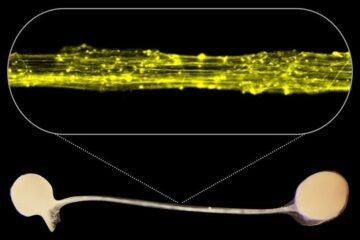Hope for arthritis stems from within

Leeds bioengineers have developed an innovative technique for cartilage repair combining the self-healing powers of the body with stem cell science to help young people avoid debilitating knee problems and give hope to arthritis sufferers.
Current treatments of cartilage defects in the knee are expensive, have lengthy recovery times, and can even cause as much damage as good. “We’re responding to a real need,” said reader in bioengineering Dr Bahaa Seedhom.
“Orthopaedic surgeons are looking for ways to repair cartilage defects in young people which will delay, maybe even prevent, the need for total knee replacement.”
The bioengineers have invented a repair technique – and tools – that cut surgery times from two hours to ten minutes, and can have patients back on their feet within three weeks. The treatment involves a surgical technique called subchondral drilling, where holes are drilled into the bone beneath the cartilage in the damaged site, causing bleeding from the bone marrow, which stimulates stem cells to grow tissue within the damaged area. Surgeons then implant a felt-like pad, to encourage the cells to expand and grow into tissue.
As the treatment uses the body’s own stem cells, it is much cheaper than existing methods, where tissue is engineered outside the body and then implanted. The system has potential for widescale applications. “Initially young people with small defects will be most suitable for treatment, but once the system has been put through its paces it might well be used for larger defects in older arthritic patients,” said Dr Seedhom.
Dr Seedhom is joined on the project by Drs Toyoda, Luo, Lorrison and Michael Pullan from bioengineering. The arthritis research campaign has awarded the project £131,000 to explain the cartilage regeneration process, and Smith and Nephew have begun an evaluation programme to commercialise the technology for clinical use within four years.
Media Contact
All latest news from the category: Life Sciences and Chemistry
Articles and reports from the Life Sciences and chemistry area deal with applied and basic research into modern biology, chemistry and human medicine.
Valuable information can be found on a range of life sciences fields including bacteriology, biochemistry, bionics, bioinformatics, biophysics, biotechnology, genetics, geobotany, human biology, marine biology, microbiology, molecular biology, cellular biology, zoology, bioinorganic chemistry, microchemistry and environmental chemistry.
Newest articles

Exploring the Asteroid Apophis With Small Satellites
In five years’ time, a large asteroid will fly very close to Earth – a unique opportunity to study it. Concepts for a national German small satellite mission are being…

First model of the brain’s information highways developed
Our human brain is not only bigger and contains more neurons than the brains of other species, but it is also connected in a special pattern: Thick bundles of neurons…

Why getting in touch with our ‘gerbil brain’ could help machines listen better
Macquarie University researchers have debunked a 75-year-old theory about how humans determine where sounds are coming from, and it could unlock the secret to creating a next generation of more…





















